

Linn Aasne Grønnerøe, Elise Nedal, Yelyzaveta Ryzha and Kjetil Skjold Nordgård.
How has the tattoo industry changed in the last ten years or so? Oslo-based tattoo artists Linn Aasne Grønnerøe and Elise Nedal offer throwbacks and foresight based on their years of experience. In this interview, they map out some major challenges and pitfalls of the tattoo industry, and how to avoid them.
After more than a decade in the business, Oslo-based tattoo artist Linn Aasne Grønnerøe decided to open her own studio, Ambrosia, in 2022. The goal: to create an inviting and comfortable environment for a variety of people, and to work on her own terms.
The studio is named after Ambrosia Tønnesen (1859–1948), regarded as the first professional female sculptor in Norway and a queer pioneer. Working mostly with naturalistic portraits carved in stone, Ambrosia Tønnesen immortalised several of her feminist contemporaries: a marble bust of radical author Amalie Skram is now on display at the Bergen Public Library, and a bronze bust of suffragist Gina Krog can be found in the star-studded Vår Frelsers cemetery in Oslo.
It was through an artist friend that Linn Aasne first heard about the norm-breaking sculptor.
‘She walked around in pants and short hair, and she managed to live off her art in the 1800s. I thought that fit well. We have a lot of customers that are “different”, so I try to create a space that works for everyone,’ she says when I meet her with colleague and Sarpsborg-native tattooist and illustrator Elise Nedal at the studio one snowy winter afternoon.
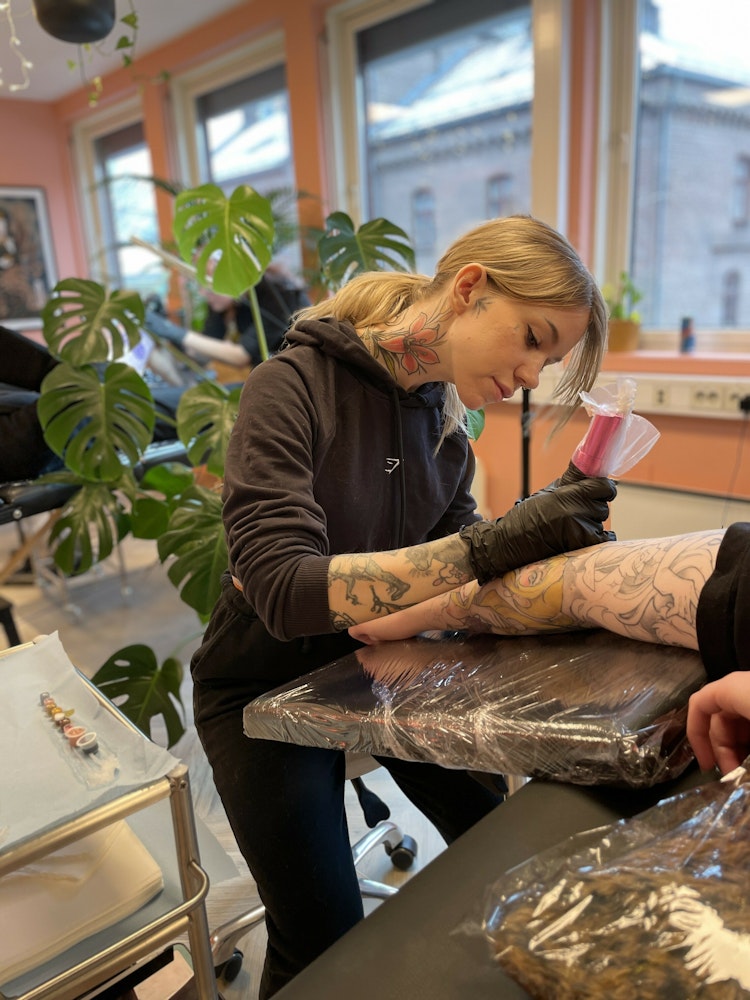
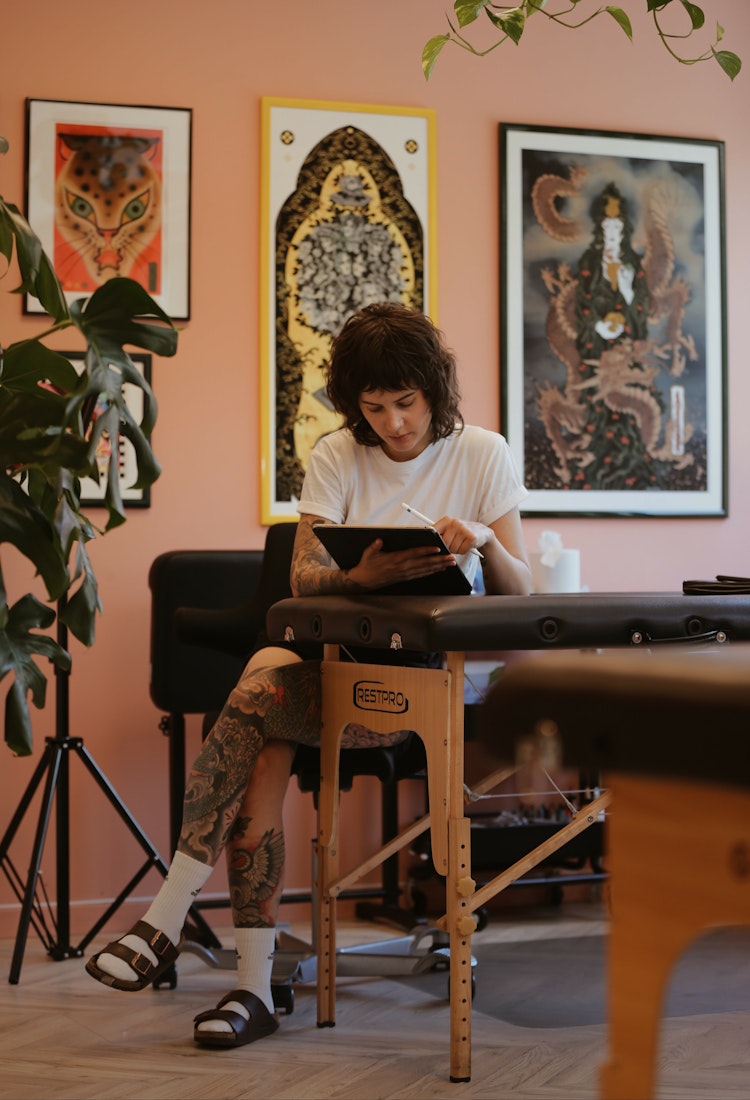
The queer-friendly tattoo studio in Grønland is run by Linn Aasne and consists of a collective of women. Those who rent a space there are Elise Nedal, Norwegian-Chilean ornamentalist Anahi Johnsen and Bristolian blackwork artist Polly Heggenes.
‘We complement each other perfectly,’ says Linn Aasne. ‘For example, I’m not the best at doing mandalas or things with a million straight lines. So, if I get a request like that, I can just pass it to Anahi. That’s her field of expertise.’
Elise, who has also worked in the industry for a long time, says one of the team’s biggest strengths is maintaining a good atmosphere. ‘About 80% of my clients are women, and I think they really appreciate that we're a women's studio. Getting a tattoo is quite intimate, and it’s very important that the customer feels cared for and safe.’
The drawing behind the tattoo
Among Linn Aasne’s most popular motifs are what she calls the ‘melting ladies’ — colourful women’s faces with wavy distortions that look like a mix between old-school pin-up illustrations and Salvador Dalí’s melting clocks. Her style could be classified as neo-traditional, or ‘neo-trad’. She explains: ‘Neo-trad draws on the traditional style, which is basically old sailors’ tattoos. Traditional tattoos follow strict rules; there’s only one line weight and a limited colour palette. So, neo-trad is like a looser version of that, where you can use more colours and a mix of thin and bold lines.’
‘You could say the motto for traditional tattoo is “bold will hold”,’ Elise interjects, ‘meaning it should be clear and solid, not so detailed.’
Tattoos and photos by Linn Aasne Grønnerøe.
As for Elise's work, it is filled with details and a variety of techniques. Like Linn Aasne, she mostly draws faces, animals and plants. Her line work is precise and delicate, with different shadings, highlights, scaled and muted colours to create the illusion of depth and light.
‘With tattoos, the drawing is usually thought of more as a sketch,’ she remarks. ‘But for me, the drawing is the whole tattoo, the whole layout, the whole design. I see the act of tattooing as just a transfer, in a way.’
When asked to define their styles, Elise lands on the umbrella term ‘illustrative’.
‘For us, the focus is really on the drawing behind the tattoo, rather than a specific tradition. I feel like styles are more of an old-school thing. There's so much more freedom now, because of newer techniques, new needles and machines, which allows you to do almost anything on skin.’
‘I really enjoy that freedom,’ says Linn Aasne. ‘As long as the basic premise of the tattoo is met, which is to think about what holds up over time on the body.’
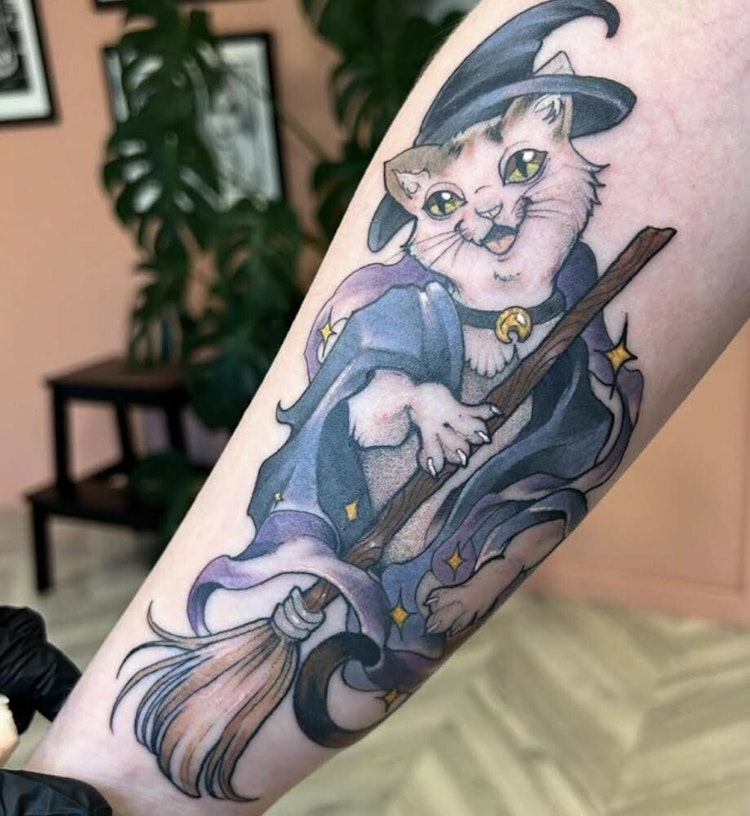

As for sources of inspiration, Elise differentiates between the technique aspect and the motifs.
‘What inspires me as a tattoo artist is completely different from what inspires me as an illustrator. Nowadays, I'm working on getting the two to meet in the middle.’
Her tip for aspiring tattoo artists is to focus on making tattoos first, and not drawings first. ‘It’s good to learn some technique and understand how the tattoo heals on the skin. For me, the transition of making my tattoos look like my drawings was long.’
‘A straight line on paper doesn't translate as straight on the body,’ Linn Aasne adds. ‘My favourite booking is when they've made an ugly drawing themselves and ask me to clean it up. It shows that they are open to adapting, and it gives me an idea or a composition to work with. That's perfect!’
Drawing on demand often requires some digging to get a proper idea of what the customer is envisioning. There are potentially many unknown factors, such as a pre-existing tattoo that wasn’t mentioned in the email exchanges, or different types of bodies and skin. As Linn Aasne points out, the conditions are ever-changing.
‘Someone may want a perfectly straight font on their forearm, without realising that it will twist when you bend your arm. Everything moves. Another may say they want something on their upper arm, but they really mean the shoulder. I wish more people would explain the kind of tattoo they want, with placement and size, by drawing it on a picture of the body part.’
‘It's hard to know what we’re working with until the person walks in through the door,’ says Elise. ‘We don't have the luxury of being able to pick and choose our canvas, because they are humans that have lived different lives. Some are 18 years old and some are 70, and they have totally different skin. And on top of that, they come with their own personality too, which you have to deal with!’
She jokes, ‘You have to be part psychologist, mind reader and artist.’
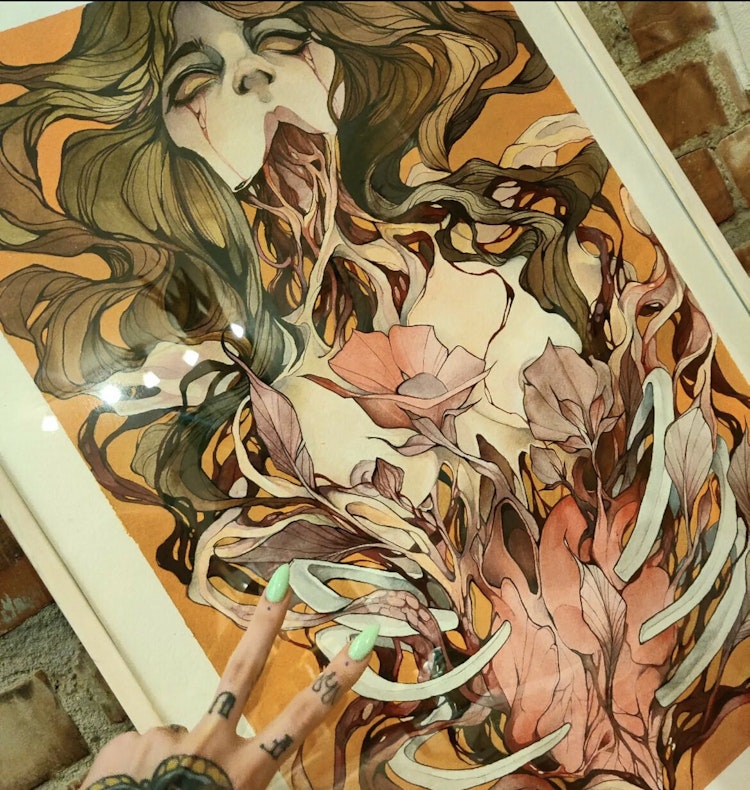
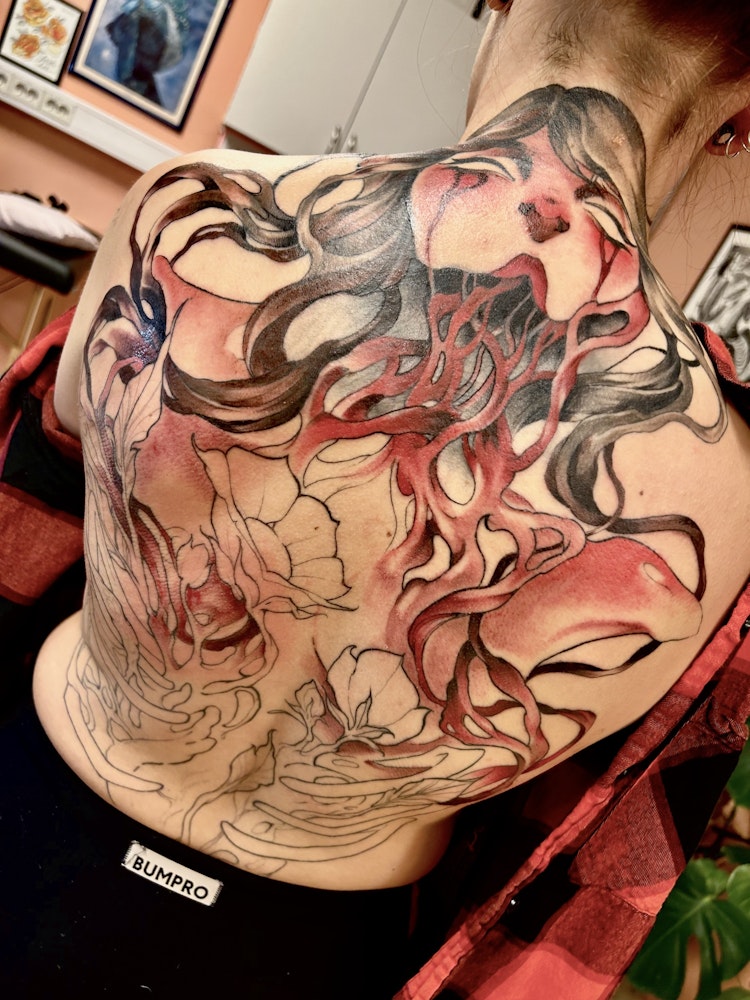
From gatekeeping to fair game
As in all other industries, tattoo technology has evolved quickly in recent years. Broadly speaking, there are two types of machines. The traditional coil machine uses a magnet to tap the needles into the skin. The newer rotary machine uses a small motor, which eases up the pressure and lightens the weight of the device.1
‘Ten years ago, if you walked into a tattoo studio, it was very noisy with a lot of buzzing from these machines, heavy old coil machines with lots of wires all over the place. Now, it’s all nice and quiet, even at tattoo conventions,’ says Linn Aasne.
‘A lot has also happened in the last two to three years. Even with rotary, you would have to get one machine for lining, one for shading, one with give and one without. Now you have one machine for everything,’ says Elise.
‘Before I started tattooing, they had to make their own needles as well, so-called soldier needles,’ Linn Aasne adds. ‘The parts had to be bought separately and fused together from scratch. And for building and tuning a machine, you had to find somebody to learn all that from.’
While a coil machine can be tuned, fixed and potentially kept for a lifetime, Linn Aasne describes the newer machines as disposable. Still, since you don’t need to build your own machines anymore, and information is more readily accessible with the rise of social media, the field is no longer so difficult to get into — which has led to some positive ripple-effects. ‘People know they have options now. Whether it’s from social media or word of mouth, they know they don’t have to endure the bullshit that we experienced as apprentices.’
‘For me, tattooing means that I can make a living from something that I am passionate about. It's really cool and I'm very grateful for the trust people give — and money and time and pain.’
Linn Aasne started her apprenticeship in 2009, but almost two years would pass before she was allowed to do her first tattoo. ‘There’s a lot of weird people in this industry,’ she laughs. ‘A lot of sucky men, for example. I’ve had a lot of bad experiences. I didn’t fit in a lot of places.’
As there is no official education for tattooists, she points out the potential pitfalls of being an apprentice: ‘The principle of an apprenticeship is that you work for free in a studio in exchange for a free education. But often you're left not learning much, because they're just using you as free labour, like, washing floors. There's a lot of exploitation. Plus, each studio is managed differently, because there are no guidelines.’
Elise started her apprenticeship in 2016 after finishing a degree in illustration, but soon suffered similar disillusions to Linn Aasne. Ten-hour days, six days a week, without pay, and industry gatekeeping. ‘I got scolded every time I sat down to draw, which is what I thought I was supposed to do.’
‘Of course, there are also good people in the industry, who guide and support you through the learning process,’ Linn Aasne adds.
‘Learning from a tattoo studio is still absolutely safer than learning from YouTube,’ says Elise. ‘Many studios will still not take on board self-taught artists, so if this is something you want to take seriously — prioritise getting an apprenticeship!’
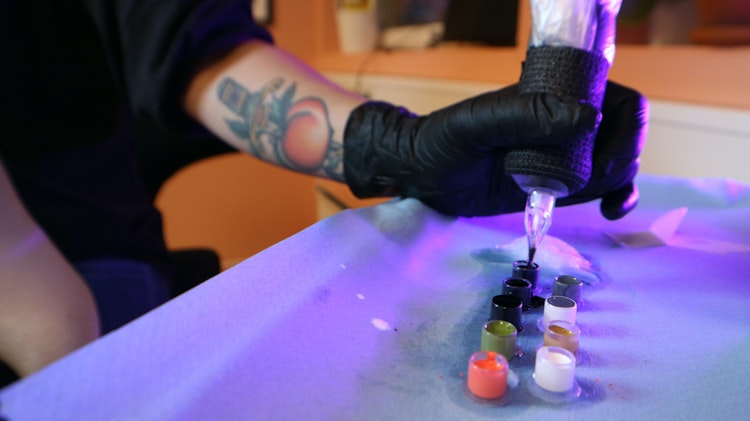
More talent, less mass production
Today, the women are happy to be able to live full time off an artform.
‘I feel lucky, but I've worked for it,’ says Elise. ‘For me, tattooing means that I can make a living from something that I am passionate about. It's really cool and I'm very grateful for the trust people give — and money and time and pain.’
Linn Aasne nods in agreement: ‘Even though it's a lot of work and you're also an accountant and influencer at the same time, we have a lot of freedom.’
But what about the future?
‘All these people are entering the profession nowadays, but many seem to be sitting around waiting for that assembly line to run by itself,’ Elise says. ‘Those who get customers are the ones who work the hardest. Working hard now doesn't just mean tattooing all the time — it means having an online presence, having TikTok, Instagram, posting your designs but also selfies. I’m interested to see if the new wave holds out,’ she wonders.
‘There will probably be a discussion at some point about whether it should continue to be fair game like now,’ says Linn Aasne.
Expressing oneself with the body is so fundamentally human that tattoos will never go out of fashion.
‘Tattoo artist is not a protected title, so anyone can do it. Should it become a protected title, as if so, what will that look like? What would an official education be like? Who should be responsible for it? Maybe it should be state-funded, like an art academy, with an application process and experienced tattoo artists who are paid as teachers. Then we would have a chance to retire when we have body aches and become teachers instead, right?’
‘It's hard to say what the future will hold, because tattooing has both changed and been so stable for so many years,’ says Elise. ‘More and more often, clients don't seem to care whether the designs are copied from the web or made on demand.’
While she worries about the increase in assembly line shops — studios with a high turnover of clients and apprentices, where styles and motifs are copied off the internet, showing little interest in creativity and individuality — she doesn’t believe that tattooing is going anywhere.
‘Expressing oneself with the body is so fundamentally human that tattoos will never go out of fashion. But the threshold for becoming a tattoo artist is so low, and there are so many apprentices, that it is impossible to predict how things are going.’
‘I hope it develops more in the direction of the art world than, say, hairdressing,’ says Linn Aasne. ‘The worst-case scenario is something like Cutters. I want better quality, more focus on the craft, improved design and more talented people coming in.’
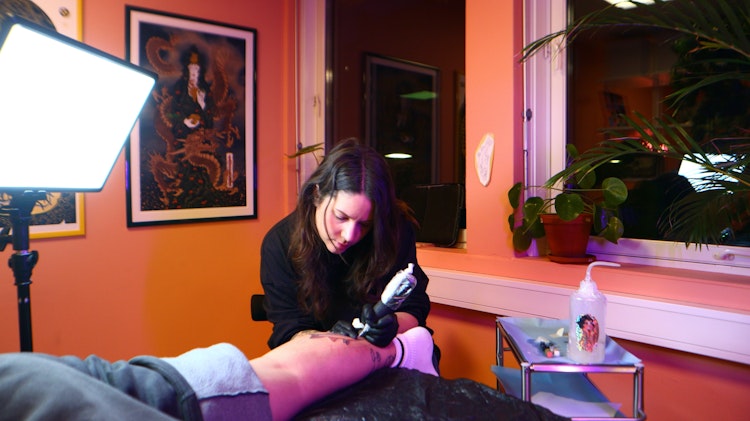
Sources:
Gillow-Kloster, Hannah. 2017. Ambrosia Tønnesen. Skeivt arkiv. https://skeivtarkiv.no/skeivopedia/ambrosia-tonnesen
Kvinnehistorie.no. 2009. Balansekunstnaren Ambrosia Tønnesen. Updated in 2023. https://www.kvinnehistorie.no/artikkel/t-8036
Store Norske Leksikon. 2005. Ambroisa Tønnesen. Updated June 29. 2022. https://nbl.snl.no/Ambrosia_T%C3%B8nnesen





